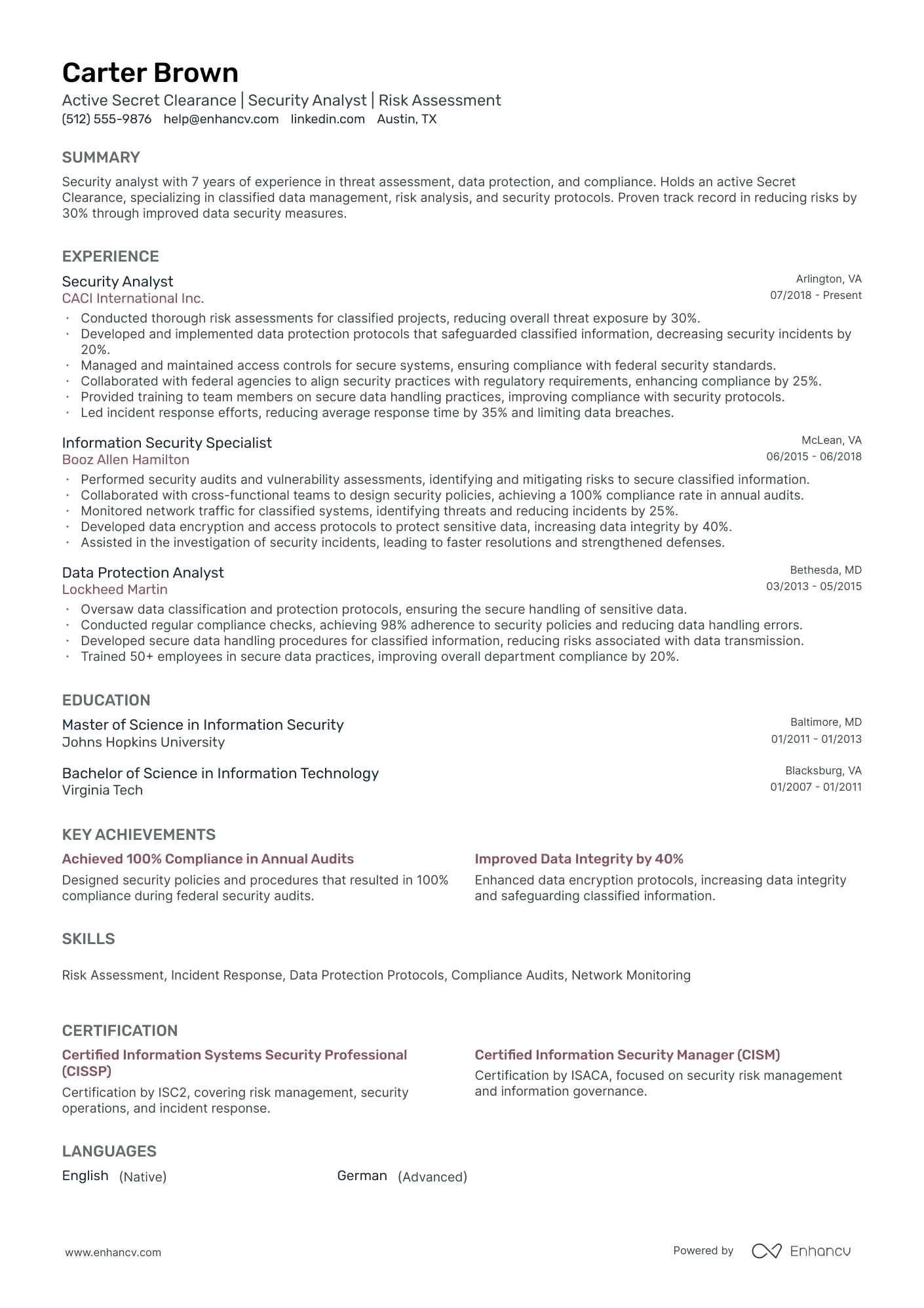Holding a security clearance isn’t just a credential—it's a mark of trust and responsibility that employers value highly. But here’s the question: how do you make it noticeable on your resume without overwhelming the rest?
This guide will walk you through the best ways to spotlight your security clearance, so it strengthens your profile and catches the eye of recruiters looking for top talent in federal roles.
From deciding where to place it to knowing what details to include, we’ll help you make your security clearance a powerful addition to your resume.
What is a security clearance?
A security clearance is an official authorization that allows individuals to access classified information, restricted areas, or sensitive data within government agencies, defense sectors, or private companies working on classified projects.
It’s typically granted by a government body after a thorough background check, which may include reviewing criminal, financial, and personal history, as well as an evaluation of loyalty and trustworthiness.
PRO TIP
Specify if your security clearance is active, and include the dates of validity for reference.
Now, let’s explore the different types and what each level entails.
Types of security clearance
Security clearances are generally categorized into three main levels, each granting access to progressively more sensitive information.
Here’s a quick look:
Confidential
This entry-level clearance allows access to information that could cause limited damage to national security if disclosed. It’s common for lower-level administrative and support roles within government.
- Entry-level security clearance
- Grants access to information that could pose a potential threat to national security
- Involves a National Agency Check with Local Agency and Credit Verification (NACLC)
- Requires a reinvestigation every 15 years
Secret
A mid-level clearance permits access to information that, if compromised, could cause significant harm to national security. Many defense and intelligence roles require at least a Secret clearance.
- Mid-level security clearance
- Grants access to information that could pose a significant threat to national security
- Requires reinvestigation every 10 years
- Involves a National Agency Check with Local Agency and Credit (NACLC)
Top secret
The highest clearance level grants access to information that, if revealed, could cause exceptionally grave damage to national security. Top Secret clearance is reserved for roles with the most sensitive responsibilities, often in national intelligence and high-level defense positions.
- Highest level of security clearance
- Provides access to information that could lead to extreme threats to national security
- Requires renewal through reinvestigation every 5 years
- Involves a Single Scope Background Investigation (SSBI)
Some agencies may also have further designations, such as Top Secret/SCI (Sensitive Compartmented Information) or Top Secret/SAP (Special Access Programs), which provide additional access controls for highly specialized information.
Understanding these clearance types and designations can help you decide the best way to present your credentials. Now, let’s look at when it’s most effective to list a security clearance on your resume.
When to list a security clearance on a resume
- Applying for government or defense roles: If you’re aiming for a position that requires or values security clearances, showcasing yours upfront can strengthen your application.
- Positions requiring high security and confidentiality: Many private sector roles in industries like cybersecurity, defense contracting, or infrastructure benefit from candidates with clearance.
- Active, relevant clearance: If your clearance is active, it’s generally worth noting. For expired or inactive clearances, consider relevance to the job.
- Projects with classified or sensitive information: If you’re applying to positions where projects involve classified or proprietary data, listing your clearance shows you’re prepared to handle such responsibilities.
- Highlighting trustworthiness and reliability: Even in roles without clearance requirements, having one can demonstrate your reliability and the thorough vetting process you’ve passed.
- Showing specialized experience: For roles that involve specialized skills often linked to secure environments—such as intelligence analysis, secure communications, or government consulting—a clearance emphasizes your unique qualifications.
- Competitive edge in highly regulated fields: In industries like finance, energy, and health care, where security is paramount, a clearance can provide an advantage, demonstrating a high standard of trustworthiness.
Just as there are good reasons to include your clearance, there are also cases where it’s best to omit it. Here’s when to keep it off your resume.
When NOT to list a security clearance on your resume
- Irrelevant job role: For positions that don’t require a security clearance or aren’t within a secure industry, listing it may add unnecessary details that don’t align with the role.
- Privacy concerns: Disclosing your clearance might expose you to unwanted attention or pose security risks.
- Inactive clearance: If your clearance is expired or inactive, mentioning it could mislead employers.
- Entry-level positions: In roles that don’t involve sensitive information, particularly at the entry-level, a clearance may be unnecessary and could clutter your resume.
- Overemphasizing in non-secure fields: In non-government or defense-related fields, a clearance could seem out of place and might suggest an over-focus on government work.
- Protecting sensitive information: If you’re unsure how much to reveal about your clearance or its details, err on the side of caution and exclude it.
On the NSA’s official website, you can find a complete guide on the dos and don'ts of listing security clearances on your resume.
Where to put security clearance on resume
Including a security clearance on your resume can be a powerful addition, especially for roles in government, defense, and security-sensitive fields. But knowing where and how to list it makes all the difference in making your qualifications stand out.
Let’s explore strategic ways to position your clearance to maximize its impact.
How to present security clearance in the header
Placing your security clearance directly in the header makes it immediately noticeable, especially if it’s essential to the role. Use clear, concise phrasing like “Active Top Secret Clearance” or “Security-Cleared Professional” to convey your clearance status.
This approach is particularly effective for government or defense positions, where hiring managers may prioritize candidates with the required clearance level from the start.
How to present security clearance in the summary
Including your clearance in the summary section allows you to highlight it alongside your key qualifications, setting a strong first impression.
Consider phrases like “Detail-oriented analyst with Active Top Secret Clearance and 7+ years of secure data management experience.”
This technique underscores your qualifications and signals to recruiters that your profile aligns with secure job requirements right from the start.
How to present security clearance in the experience section
Another option is to mention your clearance within the work history section and emphasize its importance in past positions.
- •Held Active Top Secret Clearance to support high-stakes national security initiatives.
- •Led cybersecurity efforts to safeguard classified networks and sensitive data, preventing security breaches across multiple government systems.
- •Conducted advanced threat detection and incident response, reducing security incident response time by 40%.
- •Collaborated with cross-functional teams to design and implement robust security protocols, enhancing data protection standards across the organization.
- •Trained team members in secure communication practices and compliance measures, resulting in a 25% improvement in audit performance.
How to present security clearance in the certifications or licenses section
Many fields regard an active security clearance as a credential in its own right. Including it here, under a dedicated “Certifications” or “Licenses” section, reinforces it as a professional qualification, much like a specialized license
This placement works particularly well if the clearance is active, as it outlines it as a current and relevant qualification for secure positions.
Frequently asked questions about security clearance
When do you need security clearance?
As we already mentioned earlier in the article, security clearance is needed for roles that involve access to classified or sensitive information, often in government, defense, or private sectors handling national security data.
How can you get a security clearance?
To obtain a security clearance, you typically need sponsorship from an employer or agency. After sponsorship, a thorough background investigation is conducted to assess your eligibility, focusing on factors like trustworthiness, reliability, and loyalty to national interests.
Why might security clearances be denied?
Clearance may be denied due to factors like criminal history, financial instability, substance abuse, or foreign influence, as these may pose risks to security and trustworthiness.
In conclusion
In most cases listing a security clearance on your resume will enhance your candidacy for roles in government, defense, and secure industries. Strategically placing it throughout your resume allows it to boost your profile naturally, making it an asset rather than a distraction.
Make one that's truly you.




